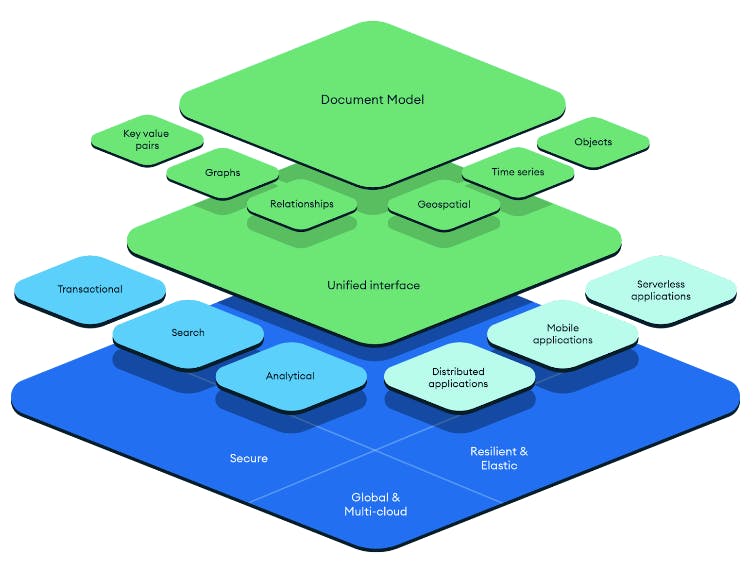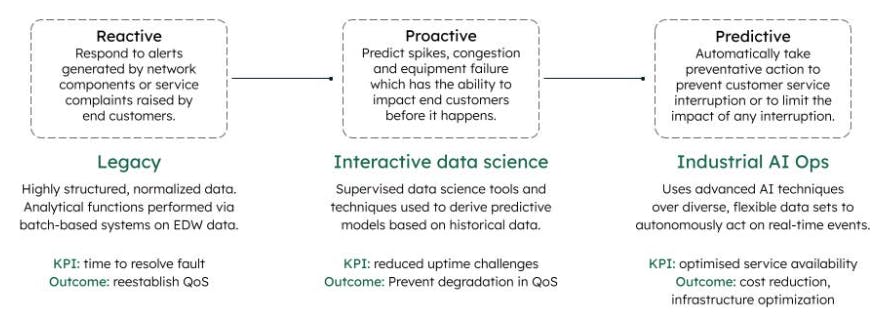4 Ways Telcos Deliver Mission-Critical Network Performance and Reliability
Tech leaders like Google, Apple, and Netflix set a new standard for customer service. Today’s customers expect intuitive, always-on, seamless service that challenges telecommunications companies’ network performance and reliability. This article examines several ways that companies can meet these challenges through an automated, data-driven approach.
How a modern data platform can help
A fully integrated, customer-centric, and data-driven approach to service delivery and assurance is needed to remain competitive. Modern telecommunications enterprises are tackling this problem by investing in areas like AI and machine learning, for example, which can help them identify correlations between disparate, diverse sources of data and automate end-to-end network operations, including:
Network security
Fraud mitigation
Network optimization
Customer experience
Furthermore, by adopting a modern data platform, companies can easily answer questions, such as the following, that are nearly impossible to resolve when relying on legacy technology:
Is an event likely to have a customer impact?
Are customer-facing service SLAs being met?
Where should cell sites be placed for maximum ROI?
Is new equipment deployed and configured correctly?
MongoDB’s modern database can help companies provide the necessary performance and reliability to meet customers’ expectations in four key areas: reducing data complexity, service assurance automation, network intelligence and automation, and TM Forum Open APIs.
Reducing data complexity
One recent study found that data scientists spend about 45% of their time loading and cleansing data. For a true impact to your organization, you need to free up that time to enable data scientists to focus on mission-critical projects and innovation. Additionally, architectural complexity, with bolted-on solutions and legacy technology, prevents you from harnessing your data and having a true impact on network performance and reliability.
MongoDB’s modern database solves the great complexity problem by supporting a diverse range of workloads from a single data platform. Reducing the channels for data flow allows companies to establish a single source of truth, achieve a customer-centric approach that is critical for competitive advantage, and increase service assurance.

With continuous uptime and advanced automation, MongoDB’s modern database ensures performance, no matter the scale.
Service assurance automation
In telecommunications, always-on, always-available service both for the end user and internal IT teams is critical. While outdated service assurance processes may have been viable decades ago, the volume of data and number of users have grown exponentially, making manually intensive processes of the past no longer possible. This volume increase will continue to stress existing business support systems, and without modernization, it will hamper the development of new revenue streams.
Moving from a reactive to proactive and then predictive model, as shown in Figure 2, will enhance service assurance and enable organizations to meet the expectations of the digital-native customer.

Network intelligence and automation
Consider the essential task of configuration and management of radio access networks. On a daily basis, engineers change the angles of antenna towers, the configuration of the radio, the nearest neighbor relations, and other events your system tracks and manages.
With an intuitive modern database, any change in the configuration is saved in the data mediation layer (DML) for anyone to see and track, making it easy for engineers to go to the DML to check the configuration for a particular tower. Information that was previously captured in one snapshot per day is now propagated in real time.
Another example — intent-based automation — abstracts the complexity of underlying software-defined networking components by allowing intent to be specified and by providing automatic translation. This type of automation allows teams to process intent generated either by end user activity or via service assurance processes, and that intent is translated into the underlying network state.
Network events determine whether the network is in the desired, stable state, and that unintended states are addressed via automation, potentially using TM Forum Network-as-a-Service APIs.
TM Forum Open APIs
The TM Forum (TMF) is an alliance of more than 850 companies that accelerates digital innovation through its TMF Open APIs, which provide a standard interface for the exchange of different telco data models. The use of TMF Open APIs ranges from providers of off-the-shelf software to proprietary developments of the largest telecommunications providers.
In working with many of the world’s largest communication service providers (CSPs) and their related software provider ecosystems, MongoDB has seen a significant number of organizations leverage these APIs to develop new microservices in days, rather than weeks or months. Through exposing common interfaces, CSPs are able to adopt a modular architecture made up of best-of-breed components (either internally or externally developed) while minimizing the time, effort, and cost required to integrate them.
The TMF Network-as-a-Service APIs, in particular, hold significant potential for network automation. This API component suite supports a set of operational domains exposing and managing network services. The abstraction layer between network automation tooling and the underlying network infrastructure provides a flexible, modular architecture.
Network optimization is vital to the survival of telcos in today’s competitive market. However, with a modern database underpinning your network, you’ll be equipped to meet and exceed customer expectations.